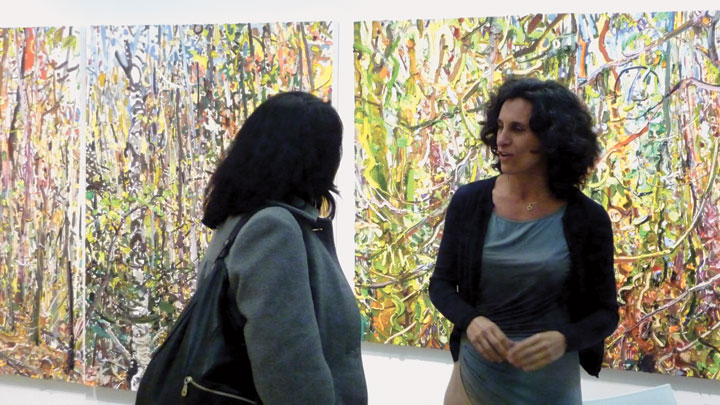Between four days, three renowned fairs, and within a few miles of each other, Miami clearly made its voice heard in the contemporary art community during the week of the Armory Show 2011 in New York City. Each fair brought a unique element to the hectic week of events, lectures, launches and exhibitions, and several galleries astutely represented the Magic City during the madness. Stepping into each venue and seeing each booth with the word “Miami” written below it, it was like being instantaneously flown from the biting New York winter into the warm Miami sunshine.
Beginning with the Armory Show itself, stationed at Piers 92 and 94; the show’s quality was, overall, underwhelming. A welcome sight, however, was Fredric Snitzer’s booth showing work from John Pylypchuk (with his pink, drip-wax “Fighting Robots” displayed in the open space of the booth). The combination of the dialogue between the sculptural oddities and the minimal wall displays was digestible, yet visually engaging. There may have been plenty of bursts of outrageous color and inventive multimedia projects throughout the space, but striding past Snitzer’s booth felt comforting. Many booths at the Armory suffered from an overcrowding of works in a small area or, generally, a poor curatorial sense between artists’ practices. Snitzer, thankfully, was a sight for sore and jet-lagged eyes.
Miami was generously represented at Scope NY at its new location across from Pier 40, with 101/Exhibit, Black Square Gallery, Butter Gallery, Carol Jazzar, Hardcore Art Contemporary, Now Contemporary Art and Spinello Gallery, all offering a lush variety of works aimed to please crowds, curators and collectors alike. Adam Wolfson’s Design District outfit 101/Exhibit presented predominantly painted works from Marcus Jansen, Marilyn Manson (yes, one in the same) and Jorge Santos in all of their youthful rage. Anna Milashevych brought Argentinean Pablo Lehmann’s delicate paper cutout In Praise of Text as her booth’s focus for Black Square. Francisco De La Torre of Butter Gallery featured a large canvas filled with Ahol Sniffs Glue’s droopy eye graffiti signature, digitally-tweaked photography from Yuri Tuma and Tawnie Silva’s acerbic, laugh-out-loud felt posters (echoing the happy extravagance of a circus). Carol Jazzar’s sprawling booth was a solo presentation of the kaleidoscopic forests by Cuban-American painter Lilian Garcia-Roig. The fair welcomed visitors at the entrance with the black walls of the Spinello Gallery, with the debut of Antonia Wright’s film Are You OK?, a wild spew of a colored Fountain (Confetti Death Series)’from TYPOE, and Kris Knight’s elegant portraits from his New Works.
Volta NY seemed to be the most ambitious collection of site-specific installation, film and mixed media works throughout the varying fairs. Two Wynwood galleries pitched the flag for Miami on the 11th floor of the 7 West Building on 34th Street, Alejandra von Hartz and Nina Johnson of Gallery Diet. Johnson chose large-scale works from painter Kristopher Benedict with his wistful series Cat in the Clouds, recalling various scenes from romantic comedy films. Von Hartz elected Uruguayan multimedia sculptor Ana Tiscornia to represent her space, with varying structures forged from paper collages, wood and cardboard elements.
As a general observation, it appears that Miami’s galleries and their artists have found a clear, discernible rhythm among the New York-dominated fairs during Armory week. Miami is readily called to memory in the art world for the winter edition of Art Basel, Art Basel Miami Beach, as well as for several local artists that has achieved national and international recognition. Between Scope, the Armory and Volta, however, new and different names were presented to thousands of international viewers. Without excessive pretense or fanfare, these Wynwood/Design District-based creatives capably held their ground amidst powerhouse dealers from London, Paris, Hong Kong and Berlin (to name a few) and academically canonized artists including Gerhard Richter, Andy Warhol, Richard Prince and Damien Hirst (as some examples). The over-arching sentiment of Miami-based gallerists and their artists (who could attend) was one of optimism with a notable tinge of forward-thinking motivation for future fairs.
Whenever and wherever Miami, as a contemporary art entity, sprung forth in conversation, the underlying tone of doubtful cynicism was no longer present in the process. Heads of respected dealers and arts magazines nodded when Miami was mentioned, eager to explore this strange anomaly, which used to be a mere after-party locale for Art Basel fanatics.
The public responses to Miami’s booths and the artists whose work adorned them appeared to be one of sincere curiosity, and whispers from curators and collectors could be heard as ‘wow, that gallery’s from Miami?’ Indeed they are.


Be the first to comment